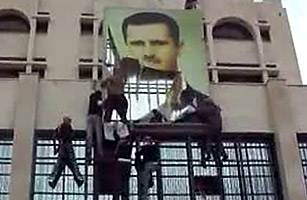
The oppressive heat has become insufferable in Syria — and as the temperature climbs, emotions get harder to contain. For three months, peaceful protests have been met with gunfire, mass arrests and torture. Now, the patience of many anti-regime Syrians is being tested as horror stories of police brutality are whispered behind closed doors. President Bashar al-Assad’s regime has blamed the unrest on “armed extremist groups,” a claim that most activists tend to dismiss as regime propaganda. But reports of skirmishes in a northwestern border town seem to point to a likelihood that citizens are taking up arms. Assad has long denounced Syria’s protest movement as militant but now, it appears, he may finally have earned himself a bona fide armed uprising.
Syrian state television claims 120 security forces were killed when hundreds of militants, armed with machine guns and rocket-propelled grenades, stormed government buildings and laid siege to the northwestern town of Jisr al-Shoghour on Monday. The violence appears to have erupted late on Saturday when snipers fired on a funeral march for six protesters who were killed on Friday, according to residents. Mourners then set fire to the building, killing eight members of the security forces. State television said fighting continued into Sunday and Monday when gunmen ambushed security posts before mutilating the dead bodies and “throwing them in the river.” A video image alleges to show a policeman shot dead during clashes in the town of Jisr al-Shoghour, Syria, June 6, 2011.
AFP / Getty Images
The Syrian government is now gearing up for a fight. Interior Minister Mohammed al-Shaar promised to “act firmly, with force and in line with the law” in a statement he read out on state television. “[The State] will not stay arms-folded in the face of armed attacks on the security of the homeland,” he said.
Jisr al-Shoghour is a hotbed of anti-government sentiment. The impoverished town, famous for smuggling contraband into nearby Turkey, has been the scene of weekly demonstrations and violence since March. In 1980, dozens were killed in Jisr al-Shoghour when the government — headed by Bashar’s father Hafez al-Assad — crushed an uprising, reportedly led by the Muslim Brotherhood. Two years later, Hafez killed between 10,000 and 20,000 people in neighboring Hama, using jets and artillery. If the brutal actions of Bashar al-Assad over the past three months are anything to go by, there is little doubt that the younger Assad will be just as vicious as his father. Activists say helicopter gunships and armored cars were used on Monday.
Already there are reports that residents are fleeing. One activist contacted by the Associated Press said 80% of the town’s inhabitants have fled to villages along the border with Turkey only 12 miles away. On Tuesday, Turkish authorities said 35 Syrians who made it across the border were being treated at Turkish hospitals. Human rights groups claim at least 42 people have been killed.
With foreign journalists barred from the country and many major roads blocked, it is impossible to confirm reports from either side. Activists say state television broadcasts are media stunts that the government has used to justify the killing of more than 1,200 protesters and the arrest and torture of thousands. From a public relations perspective, killing armed men is much more palatable for Syrians than the slaughter of unarmed protesters.
“Assad wants to give the image that he is fighting a sectarian insurgency rather than a civilian movement who are demanding their rights,” says an activist in Damascus. On Tuesday, to the sound of funereal music, Syrian state television showed clips of dead policemen and burning cars before airing footage of Syrian children eating ice cream in Damascus or farmers sowing seeds. The contrast is a clear message that “insurgents” are ruining the delicate balance of peace that President Assad claims to have fostered.